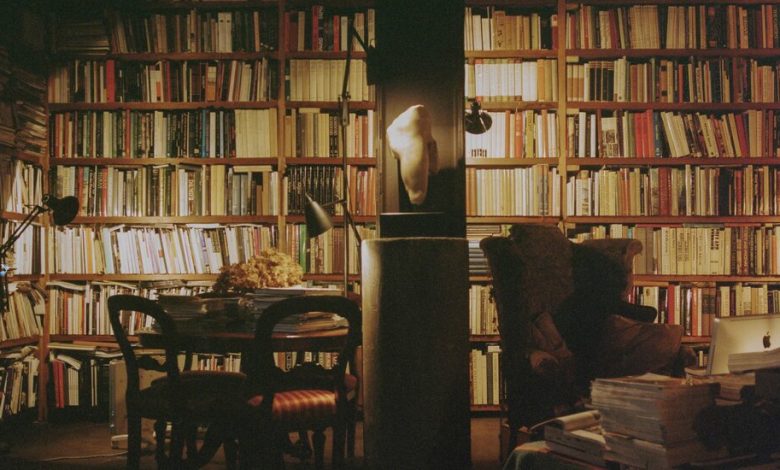A Photographer’s House of Shadows

In the Northcote suburb of Melbourne, Australia, an enclave known for its coffeehouses and music clubs, the residential streets are mostly lined with century-old wood houses. But one building stands out: the home and studios of the photographer Bill Henson and his partner, the painter Louise Hearman. A discreet black steel gate leads to a short cobblestone lane and then a towering wooden door, beyond which stands a two-story brick monolith covered in ivy.
Henson, 68, and Hearman, 60, bought the building in 1990, seduced by the way the late afternoon light flooded the 4,200-square-foot structure. Originally constructed as commercial stables in 1880, it was turned into a garage and scrap metal business after World War II. Now it’s reconfigured as a work and living space: The ground floor holds the couple’s studios, including Henson’s archives and collections of books, photographs, paintings and other mementos. A mezzanine upstairs — once a storage place for engines and gearboxes — runs along the western edge of the building. It was refloored with salvaged jarrah, a Western Australian timber, and now serves as the pair’s living area.
Henson grew up in what was then a semirural suburb outside of the city. When he was 19, after he’d dropped out of art school, his work was shown at the National Gallery of Victoria. In the decades since, he’s become one of the country’s most prominent photographers, known for his Caravaggio-like command of light and shadow in landscapes and portraits. (In 2008, his images of naked adolescents prompted a police raid on an exhibition in Sydney. But many in Australia’s creative community came to his defense, and authorities declined to press charges.)
The photographer’s studio is itself a study of light and shadow. Occupying most of the ground floor, the 1,800-square-foot, 30-foot-high-ceilinged space is contained within weathered brick walls and topped with a distant skylight covered, like the windows, with shutters Henson manipulates to create an optimal mix of natural and artificial light. He uses dozens of heavy brass or generic metal desk lamps to “help shape a room,” he says, as a set designer might. “You can kill a room or make it beautiful just with light.” In the makeshift foyer, on a row of mismatched side tables, are a few treasured books, including Vladimir Nabokov’s multivolume translation of Alexander Pushkin’s “Eugene Onegin,” and a black-and-white photo of a serene Thomas Mann, one of Henson’s favorite authors, spotlit by lamps. Across the room in front of a bare brick wall sits a high-backed chair, upholstered in a red-and-black Turkish kilim; propped on it is a small oil-on-Masonite painting by Hearman of a young girl floating in water.
The expansive living area above the studio, entered via a steep set of wooden steps, is decorated in tones of brown and gray. Here there’s a dormer roof lined with dark wood, anchored by steel beams, from which hangs a heavy cast-bronze chandelier. The open kitchen reflects the same color scheme — gray pans hang from a gray wall next to a dark gray refrigerator — while more desk lamps cast parabolas of light on the walls. At one end of the living space is Henson’s study. Thousands of books fill the 10-foot-high shelves or are piled on tables: novels, criticism, art, history and rare and first editions, including Petronius’s “Satyricon” and Joris-Karl Huysmans’s “Against the Grain.” There’s no cataloging system, just “clumps and thickets of associations,” says Henson.
The compound’s outdoor areas are equally idiosyncratic. In 2004, Henson and Hearman bought the lot next door, part of the same postwar garage complex as their home. Henson uses the main building — whose 15-foot-high doors slide open like an aircraft hangar’s — to shoot some of his work, and he has transformed its old parking lot into a botanical garden dense with arching peppercorn trees, cypresses and towering palms. Spread across the ground are family heirlooms of a sort: dozens of clivias, the bush lily native to South Africa, and arrays of shiny black basalt stones, along with other elements from his mother’s garden that he moved here after she died in 2016.
Back inside the house, Henson heads into one of the dark recesses of his studio to point out a large, scuffed wooden chest with three-foot-long flat-file drawers. It was his mother’s, he says, and inside is her collection of her son’s earliest artworks — landscapes and seascapes; sketches of school friends in dark charcoal or filigreed lines; meticulous recreations of complex pieces of architecture and renderings of Egyptian tombs and hieroglyphics. It’s the kind of eclecticism you might expect of a young artist, easily enchanted by the world around him and eager to make sense of it. All around the chest are shelves, racks and tables piled high with books, prints and other miscellany, more evidence that he never outgrew his curiosity. “It’s clutter, yes, but it’s my clutter,” says Henson. “One creates an environment, to the best of one’s ability, that gives you pleasure.”
